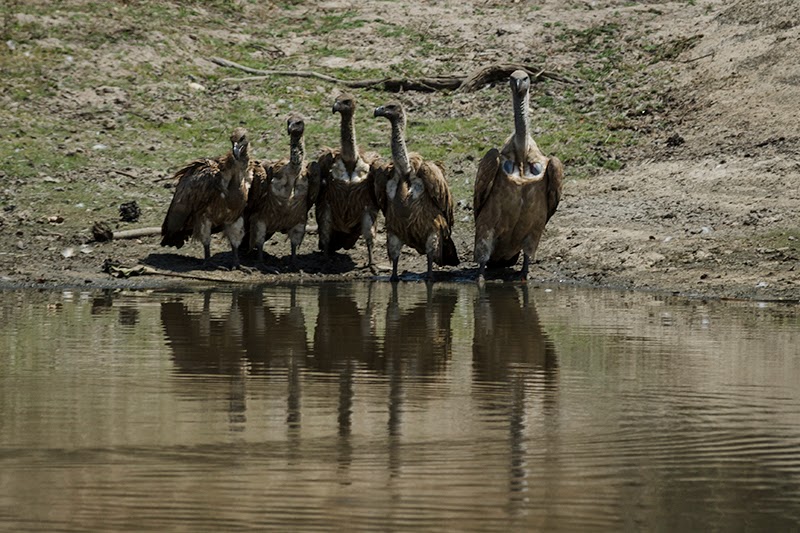One of the many incredible facets of nature
is its efficiency. Nothing goes to waste
out here: a derelict termite mound can be home for a multitude of species from
hyaenas to snakes and an old wasp gall provides the perfect home for a
spider. But it is not just the recycling
of real estate that makes it so special.
Dealing with dead matter is a massively important affair. Without its processing, the risk of disease
is very real as a decaying organism is the perfect breeding ground for some of
Mother Nature’s more unsavoury organisms.
 To combat this threat, nature has given us
a few select species that specialize in this area. They are the sanitation team of the bush and
they love their job! The other day we
found a dead hippo on the banks of one of the local waterholes. By the time we arrived on the scene the
animal looked as though it had been dead for a few days and not much remained
of the amphibious giant but its demise had already benefited a whole host of
scavengers. As we sat in the baking midday
heat, the scorching temperatures did not seem to bother the wake of vultures
that fought over the remaining scraps of nutrient rich flesh. With no regard for table manners, they
entertained us for ages with their petty squabbling. Sharp bills stabbed at their fellow dinner
guests and wings were spread in anger every few minutes as they tore strips of
flesh to store in their crops for digestion later.
To combat this threat, nature has given us
a few select species that specialize in this area. They are the sanitation team of the bush and
they love their job! The other day we
found a dead hippo on the banks of one of the local waterholes. By the time we arrived on the scene the
animal looked as though it had been dead for a few days and not much remained
of the amphibious giant but its demise had already benefited a whole host of
scavengers. As we sat in the baking midday
heat, the scorching temperatures did not seem to bother the wake of vultures
that fought over the remaining scraps of nutrient rich flesh. With no regard for table manners, they
entertained us for ages with their petty squabbling. Sharp bills stabbed at their fellow dinner
guests and wings were spread in anger every few minutes as they tore strips of
flesh to store in their crops for digestion later.
We were delighted to see that a large
percentage of the raptors present were in fact Cape Vultures. This species, endemic to southern Africa is
considered vulnerable in its status with estimates numbering less than 10,000
left in the world. Unfortunately, the
largest of the vulture family is under threat due to the traditional medicine
(or ‘muti’) trade. Amongst other things,
their eyes are especially sought after as they are believed to aid in foresight
for the consumer. Despite their plight,
the towering Drakensburg that watch over the Lowveld provides perfect nesting
opportunity for this impressive bird and thus, numbers in this area are among
the most dense to found anywhere within its range.
Whilst delighting in their meal, they
always kept a careful eye on the resident crocodile. At about 3 meters long, it is not the largest
to be found on the reserve but still a formidable adversary should one stray
too close to its indiscriminate jaws! It
lay in the shallows next to the carcass occasionally grabbing mouthfuls of
decomposing flesh, twisting its streamline body violently to rip off chunks of
meat to be swallowed whole. Such a meal
will keep it satiated for months to come no doubt. Tracks of other scavengers litter the area
with both jackal and hyaena spoor found in abundance.
Despite their unsavoury reputation,
nature’s clean-up crew perform a vital role within the ecology. It is incredible to think that a near 2 ton
animal can be reduced to pile of bones in only a few days. The way in which a carcass is systematically
dismantled in such a short time is mightily impressive and with the help of the
resident sanitation engineers, from hyaena to crocodiles, to vultures, to the
humble ants, these vital nutrients will be put back into the soil ready to feed
the next generation of organisms. It is
one of many miracles of nature that everything has its place. Its efficiency is ruthless. There is almost no role that is not fulfilled
in nature and its level of organisation is so far beyond our own
self-proclaimed intelligence that our society pales into insignificance in
comparison!
Article and photos by Ben Coley









No comments:
Post a Comment